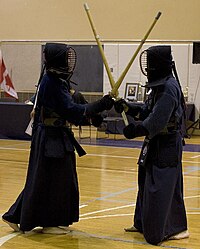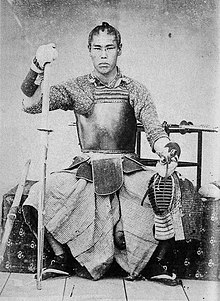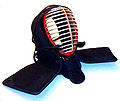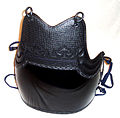Bruger:Lucifax/sandkasse 2
| Lucifax/sandkasse 2 | |
|---|---|
| Kanji | 剣道 |
| Hiragana | けんどう |
| Hepburn | Kendō |
| Kunrei-shiki | Kendô |
 | |
Kendo (剣道 kendō) betyder sværdets vej og er en moderne japansk kampsport baseret på traditionel japansk sværdkamp.[1]
Kendo er en fysisk og mentalt udfordrende aktivitet der kombinerer stærke kampsportsværdier med sportslig aktivitet.
Udøvere
[redigér | rediger kildetekst]Udøvere af Kendo kaldes kendōka (剣道家), der betyder "en som øver kendo", [2] eller lejlighedsvist kenshi (剣士), der betyder "sværdkæmper".[3]
"Kodansha Meibo" (et register over medlemmer med dan i All Japan Kendo Federation) viser at der per september 2007 var 1,48 millioner registrerede dan rangerede kendōka i Japan.
According to the survey conducted by the All Japan Kendo Federation, the number of active kendo practitioners in Japan is 477,000 in which 290,000 dan holders are included. From these figures, the All Japan Kendo Federation estimates that the number of "kendōka" in Japan is 1.66 million by adding the number of the registered dan holders and the active kendo practitioners without dan grade.[4]
Concept and purpose
[redigér | rediger kildetekst]In 1975, the All Japan Kendo Federation (AJKF) developed then published "The Concept and Purpose of Kendo" which is reproduced below.[5][6]
Concept
[redigér | rediger kildetekst]Kendo is a way to discipline the human character through the application of the principles of the katana.
Purpose
[redigér | rediger kildetekst]- To mold the mind and body.
- To cultivate a vigorous spirit,
- And through correct and rigid training,
- To strive for improvement in the art of Kendo.
- To hold in esteem human courtesy and honor.
- To associate with others with sincerity.
- And to forever pursue the cultivation of oneself.
- Thus will one be able:
- To love one's country and society;
- To contribute to the development of culture;
- And to promote peace and prosperity among all peoples.
History
[redigér | rediger kildetekst]
Since the earliest samurai government in Japan, during the Kamakura period (1185–1333), sword fencing, together with horse riding and archery, were the main martial pursuits of the military clans. In this period kendo developed under the strong influence of Zen Buddhism.[kilde mangler] The samurai could equate the disregard for his own life in the heat of battle, which was considered necessary for victory in individual combat, to the Buddhist concept of the illusory nature of the distinction between life and death.[kilde mangler]
Those swordsmen established schools of kenjutsu (the ancestor of kendo) which continued for centuries and which form the basis of kendo practice today.[kilde mangler] The names of the schools reflect the essence of the originator's enlightenment.[kilde mangler] Thus the Ittō-ryū (Single sword school) indicates the founder's illumination that all possible cuts with the sword emanate from and are contained in one original essential cut. The Mutō-ryu (swordless school) expresses the comprehension of the originator Yamaoka Tesshu, that "There is no sword outside the mind". The Munen Musō-ryū (No intent, no preconception) similarly expresses the understanding that the essence of kenjutsu transcends the reflective thought process.[kilde mangler] The formal kendo exercises known as kata were developed several centuries ago as kenjutsu practice for warriors and are still studied today, albeit in a modified form.[kilde mangler]
The introduction of bamboo practice swords (shinai) and armour (bōgu) to sword training is attributed to Naganuma Shirōzaemon Kunisato during the Shotoku Era (1711–1715). Naganuma developed the use of bōgu and established a training method using the shinai.[7]
In addition, the inscription on the gravestone of Yamada Heizaemon Mitsunori's (Ippūsai) (山田平左衛門光徳(一風斎) 1638–1718) third son Naganuma Shirōzaemon Kunisato (長沼 四郎左衛門 国郷 1688 - 1767), the 8th headmaster of the Kashima Shinden Jikishinkage-ryū Kenjutsu, states that his exploits included improving the bokuto and shinai, and refining the armour by adding a metal grill to the men (head piece) and thick cotton protective coverings to the kote (gauntlets). Kunisato inherited the tradition from his father Heizaemon in 1708, and the two of them worked hard together to improve the bogu until Heizaemon's death.[7][8]

This is believed to be the foundation of modern kendo.[kilde mangler] Kendo began to make its appearance during the late 18th century.[kilde mangler] Use of the shinai and bōgu made it possible to deliver strikes and thrusts with full force but without injuring one's opponent. These advances, along with the development of set practice formats, set the foundations of kendo.
Concepts such as mushin (無心), or "empty mind", are borrowed from Zen Buddhism and are considered essential for the attainment of high-level kendo.[kilde mangler] Fudōshin (不動心), or "unmoving mind", is a conceptual attribute of the deity Fudo Myo-O, one of the five "Kings of Light" of Shingon Buddhism. Fudōshin, implies that the kendōka cannot be led astray by delusions of anger, doubt, fear, or surprise arising from the opponent’s actions, collectively called "the four kendo sicknesses" (四戒 shikai, lit. four admonitions).[9] Thus today it is possible to embark on a similar quest for spiritual enlightenment as followed by the samurai of old.[kilde mangler]
The Dai Nippon Butoku Kai was established in 1895 to solidify, promote, and standardize all martial disciplines and systems in Japan. The DNBK changed the name of gekiken (Kyūjitai: 擊劍; Shinjitai: 撃剣, "hitting sword") to kendō in 1920.[10]
Kendo (along with other martial arts) was banned in Japan in 1946 by the occupying powers. This was part of "the removal and exclusion from public life of militaristic and ultra nationalistic persons" in response to the wartime militarization of martial arts instruction in Japan. Kendo was allowed to return to the curriculum in 1950 (first as "shinai competition" (竹刀競技 shinai kyōgi) and then as kendo from 1952).[11] [12]
The All Japan Kendo Federation (AJKF or ZNKR) was founded in 1952, immediately following the restoration of Japanese independence and the subsequent lift of the ban on martial arts in Japan.
The International Kendo Federation (FIK) was founded in 1970, it is an international federation of national and regional kendo federations and the world governing body for kendo. The FIK is a non-governmental organization, and its aim is to promote and popularize kendo, iaido and jodo.
The World Kendo Championships are an FIK event and have been held every three years since 1970.
Equipment and clothing
[redigér | rediger kildetekst]Kendo is practiced wearing a traditional Japanese style of clothing, protective armour (防具 bōgu) and using one or, less commonly, two (竹刀 shinai).[13]
-
A shinai.
-
Men
-
Dō
-
Tare
-
Kote
-
Armour and clothing components
Equipment
[redigér | rediger kildetekst]The shinai is meant to represent a Japanese sword (katana) and is made up of four bamboo slats, which are held together by leather fittings. A modern variation of a shinai with carbon fiber reinforced resin slats is also used.[14]
Kendōka also use hard wooden swords (木刀 bokutō) to practice kata.[15]
Kendo employs strikes involving both one edge and the tip of the shinai or bokutō.
Protective armor is worn to protect specified target areas on the head, arms and body. The head is protected by a stylized helmet, called (面 men), with a metal grille (面金 men-gane) to protect the face, a series of hard leather and fabric flaps (突垂れ tsuki-dare) to protect the throat, and padded fabric flaps (面垂れ men-dare) to protect the side of the neck and shoulders. The forearms, wrists, and hands are protected by long, thickly padded fabric gloves called (小手 kote). The torso is protected by a breastplate (胴 dō), while the waist and groin area is protected by the (垂れ tare), consisting of three thick vertical fabric flaps or faulds.
Clothing
[redigér | rediger kildetekst]The clothing worn under the bōgu comprise a jacket (kendogi or keikogi) and hakama, a garment separated in the middle to form two wide trouser legs.[16]
A cotton towel (手拭い tenugui) is wrapped around the head, under the men, to absorb perspiration and provide a base for the men to fit comfortably.
Modern practice
[redigér | rediger kildetekst]Kendo training is quite noisy in comparison to some other martial arts or sports. This is because kendōka use a shout, or (気合い kiai), to express their fighting spirit when striking. Additionally, kendōka execute (踏み込み足 fumikomi-ashi), an action similar to a stamp of the front foot, when making a strike.
Like some other martial arts, kendōka train and fight barefoot. Kendo is ideally practiced in a purpose-built dōjō, though standard sports halls and other venues are often used. An appropriate venue has a clean and well-sprung wooden floor, suitable for fumikomi-ashi.[5]
Modern kendo techniques comprise both strikes and thrusts. Strikes are only made towards specified target areas (打突-部位 datotsu-bui) on the wrists, head, or body, all of which are protected by armor. The targets are men, sayu-men or yoko-men (upper left or right side of the men), the right kote at any time, the left kote when it is in a raised position, and the left or right side of the dō. Thrusts (突き tsuki) are only allowed to the throat. However, since an incorrectly performed thrust could cause serious injury to the opponent's neck, thrusting techniques in free practice and competition are often restricted to senior dan graded kendōka.
-
Kendōka perform sonkyo after combat.
-
Two kendōka in tsuba zeriai.
-
Kendo target areas, or datotsu-bui.
-
Two kendōka, one (left) is playing in nitō (two sword style) and the other (right) is playing in ittō (one sword style).
Once a kendōka begins practice in armor, a practice session may include any or all of the following types of practice.
- Kiri-kaeshi (切り返し)
- Striking the left and right men target points in succession, practising centering, distance, and correct technique, while building spirit and stamina.
- Waza-geiko (技稽古)
- Waza or technique practice in which the student learns and refines that techniques of Kendo with a receiving partner.
- Kakari-geiko (掛稽古)
- Short, intense, attack practice which teaches continuous alertness and readiness to attack, as well as building spirit and stamina.
- Ji-geiko (自稽古)
- Undirected practice where the kendōka tries all that has been learnt during practice against an opponent.
- Gokaku-geiko (互角稽古)
- Practice between two kendōka of similar skill level.
- Hikitate-geiko (引立稽古)
- Practice where a senior kendōka guides a junior through practice.
- Shiai-geiko (試合稽古)
- Competition practice which may also be judged.
Competition
[redigér | rediger kildetekst]A scorable point (有効打突 yūkō-datotsu) in a kendo competition (tai-kai) is defined as an accurate strike or thrust made onto a datotsu-bui of the opponent's kendo-gu with the shinai making contact at its datotsu-bu, the competitor displaying high spirits, correct posture and followed by zanshin.[17]
Datotsu-bui or point scoring targets in kendo are defined as:[18]
- Men-bu, the top or sides of the head protector (sho-men and sayu-men).
- Kote-bu, a padded area of the right or left wrist protector (migi-kote and hidari-kote).
- Do-bu, an area of the right or left side of the armour that protects the torso (migi-do and hidari-do).
- Tsuki-bu, an area of the head protector in front of the throat (tsuki-dare).
Datotsu-bu of the 'shinai' is the forward, or blade side (jin-bu) of the top third (monouchi) of the shinai.[18]
(残心 Zanshin), or continuation of awareness, must be present and shown throughout the execution of the strike, and the kendōka must be mentally and physically ready to attack again.
In competition, there are usually three referees (審判 shinpan). Each referee holds a red flag and a white flag in opposing hands. To award a point, a referee raises the flag corresponding to the colour of the ribbon worn by the scoring competitor. Usually at least two referees must agree for a point to be awarded. The match continues until a pronouncement of the point that has been scored.
Kendo competitions are usually a three point match. The first competitor to score two points, therefore wins the match. If the time limit is reached and only one competitor has a point, that competitor wins.
In the case of a tie, there are several options:
- (引き分け Hiki-wake): The match is declared a draw.
- (延長 Enchō): The match is continued until either competitor scores a point.
- (判定 Hantei): The victor is decided by the referees. The three referees vote for victor by each raising one of their respective flags simultaneously.[19]
Advancement
[redigér | rediger kildetekst]Grades
[redigér | rediger kildetekst]Technical achievement in kendo is measured by advancement in grade, rank or level. The (級 kyū) and (段 dan) grading system is used to indicate one's proficiency in kendo. The dan levels are from first-dan (初段 sho-dan) to tenth-dan (十段 jū-dan). There are usually six grades below first-dan, known as kyu. The kyu numbering is in reverse order, with first kyu (一級 ikkyū) being the grade immediately below first dan, and sixth kyu (六級 rokkyū) being the lowest grade. There are no visible differences in dress between kendo grades; those below dan-level may dress the same as those above dan-level.[20]
Eighth-dan (八段 hachi-dan) is the highest dan grade attainable through a test of physical kendo skills. In the AJKF the grades of ninth-dan (九段 kyū-dan) and tenth-dan are no longer awarded, but ninth-dan kendōka are still active in Japanese kendo. International Kendo Federation (FIK) grading rules allow national kendo organisations to establish a special committee to consider the award of those grades.
All candidates for examination face a panel of examiners. A larger, more qualified panel is usually assembled to assess the higher dan grades. Kendo examinations typically consist of jitsugi, a demonstration of the skill of the applicants, Nihon Kendo Kata and a written exam. The eighth-dan kendo exam is extremely difficult, with a reported pass rate of less than 1 percent.[21]
| Grade | Requirement | Age requirement |
|---|---|---|
| 1-dan | 1-kyū | At least 13 years old |
| 2-dan | At least 1 year of training after receiving 1-dan | |
| 3-dan | At least 2 years of training after receiving 2-dan | |
| 4-dan | At least 3 years of training after receiving 3-dan | |
| 5-dan | At least 4 years of training after receiving 4-dan | |
| 6-dan | At least 5 years of training after receiving 5-dan | |
| 7-dan | At least 6 years of training after receiving 6-dan | |
| 8-dan | At least 10 years of training after receiving 7-dan | At least 46 years old |
Titles
[redigér | rediger kildetekst]Titles (称号 shōgō) can be earned in addition to the above dan grades by kendōka of a defined dan grade. These are (錬士 renshi), (教士 kyōshi), and (範士 hanshi). The title is affixed to the front of the dan grade when said, for example (錬士六段 renshi roku-dan). The qualifications for each title are below.
| Title | Required grade | Conditions |
|---|---|---|
| (錬士 renshi) | 6-dan | After receiving 6-dan, one must wait 1 or more years, pass screening by the kendo organization, receive a recommendation from the regional organization president then pass an exam on kendo theory. |
| (教士 kyōshi) | renshi 7-dan | After receiving 7-dan, one must wait 2 or more years, pass screening by the kendo organization, and receive a recommendation from the regional organization president then pass an exam on kendo theory. |
| (範士 hanshi) | kyōshi 8-dan | After receiving 8-dan, one must wait 8 or more years, pass screening by the kendo organization, receive a recommendation from the regional organization president and the national kendo organization president then pass an exam on kendo theory. |
Kata
[redigér | rediger kildetekst]There are 10 (日本剣道形 Nihon Kendō Kata). These are performed with wooden swords (木刀 bokutō or bokken). The kata include fundamental techniques of attacking and counter-attacking, and have useful practical application in general kendo. Occasionally, real swords or swords with a blunt edge, called (形用 kata-yō) or (刃引 ha-biki), may be used for display of kata.

Kata one through seven are performed with both partners using a (大刀 daitō) or (太刀 tachi) style bokutō. Kata 8–10 are performed with one partner using a daitō and the other using a (小太刀 kodachi) or (小刀 shōtō) style bokutō. During kata practice, the participants take the roles of either (打太刀 uchidachi), the teacher, or (仕太刀 shidachi), the student. The uchidachi makes the first move or attack in each kata. As this is a teaching role, the uchidachi is always the "losing" side, thus allowing the shidachi to learn and gain confidence.
Nihon Kendō Kata were drawn from representative kenjutsu schools and tend to be quite deep and advanced.[kilde mangler]
In some areas the regular training curriculum does not include Nihon Kendō Kata.[kilde mangler] In 2003, the All Japan Kendo Federation introduced (木刀による剣道基本技稽古法 Bokutō Ni Yoru Kendō Kihon-waza Keiko-hō), a set of basic exercises using a bokuto, attempted to bridge this gap. This form of practice, is intended primarily for kendōka up to second dan (二段 ni-dan), but is very useful for all kendo students.[22]
Outside Japan
[redigér | rediger kildetekst]The International Kendo Federation (FIK) was established in 1970 to provide a link between Japan and the developing international kendo community. FIK is an international federation of national and regional organizations and the world governing body for kendo. The FIK is a non-governmental organisation, and its aim is to promote and popularise kendo, iaido and jodo. Seventeen national federations were the founding affiliates. The number of affiliated and recognised organisations has increased over the years to 50 affiliates by February 2009.
The World Kendo Championships are an FIK event and have been held every three years since 1970.
| WKC | Year | Hosting Country | Countries | Date |
|---|---|---|---|---|
| 1 WKC | 1970 | Japan | 17 | 1970/4/5-10 |
| 2 WKC | 1973 | USA | 17 | 1973/4/8-15 |
| 3 WKC | 1976 | Great Britain | 20 | 1976/4/17-18 |
| 4 WKC | 1979 | Japan | 21 | 1979/8/4-5 |
| 5 WKC | 1982 | Brazil | 20 | 1982/7/31 to 1982/8/1 |
| 6 WKC | 1985 | France | 25 | 1985/4/13-14 |
| 7 WKC | 1988 | Korea | 23 | 1988/5/28-29 |
| 8 WKC | 1991 | Canada | 29 | 1991/6/29-30 |
| 9 WKC | 1994 | France | 32 | 1994/4/9-10 |
| 10 WKC | 1997 | Japan | 34 | 1997/3/27-30 |
| 11 WKC | 2000 | USA | 36 | 2000/3/24-26 |
| 12 WKC | 2003 | Great Britain | 42 | 2003/7/4-6 |
| 13 WKC | 2006 | Taiwan | 44 | 2006/12/08-10 |
| 14 WKC | 2009 | Brazil | 39 | 2009/8/29-30 |
| 15 WKC | 2012 | Italy | 50 | 2012/5/25-27 |
See also
[redigér | rediger kildetekst] |
Wikimedia Commons har medier relateret til: |
- All Japan Kendo Federation (AJKF; ZNKR or Zen Nippon Kendo Renmei)
- Gendai budō modern Japanese martial arts
- Iaidō Sword drawing
- Jōdō A martial art using a short wooden staff, or stick
- Kendo around the world
- Kenjutsu Classical Japanese sword art
- Kirikaeshi A special exercise in Kendo training
- Koryū Old style (Japanese) martial arts
- Kumdo Korean kendo
- Naginata A martial art using a halberd like weapon
- Zen Nippon Kendo Renmei Iaido
Notes and references
[redigér | rediger kildetekst]- ^ "All Japan Kendo Federation's Perspective of Kendo". All Japan Kendo Federation (AJKF).
- ^ The illustrated encyclopedia of body-mind disciplines, Nancy Allison, Taylor & Francis US, 1999 p.293
- ^ Kendo: elements, rules, and philosophy, Jinichi Tokeshi, University of Hawaii Press, 2003 p.271
- ^ "全国剣道人口調査の結果まとまる 平成20年05月号" (Japanese). All Japan Kendo Federation. marts 2008.
{{cite web}}: CS1-vedligeholdelse: Ukendt sprog (link) - ^ a b Sato, Noriaki (1995). Kendo Fundamentals. Tokyo, Japan: All Japan Kendo Federation.
{{cite book}}: Cite har en ukendt tom parameter:|coauthors=(hjælp); Ukendt parameter|month=ignoreret (hjælp) - ^ "Concept of Kendo". All Japan Kendo Federation (AJKF).
- ^ a b "The History of Kendo". All Japan Kendo Federation (AJKF).
- ^ Tamio, Nakamura (03/01/2007). "The History of Bogu". Kendo World.
{{cite web}}: Tjek datoværdier i:|date=(hjælp) - ^ Ebihara D., Murakami I., Omoto R., Marsten J. "Promotional Exam Study Guide". Hentet 1 juni 2010.
{{cite web}}: CS1-vedligeholdelse: Flere navne: authors list (link) - ^ Thomas A. Green, Joseph R. Svinth eds (2010) Martial Arts of the World: An Encyclopedia of History and Innovation, Volume 2, pp 600-601, ABC-CLIO, ISBN 1598842439
- ^ "Documentation Regarding the Budo Ban in Japan, 1945-1950". Journal of Cambative Sport (JCS). december 2002.
- ^ Matunobu, Yamazaki and Nojima (1989), 剣道 (Kendo), Seibido Sports Series (27), Seibido Publishers, Tokyo (in Japanese)
- ^ Sasamori, Junzo (1964). This is Kendo. Japan: Charles E. Tuttle. s. 71-76. ISBN 0-8048-0574-1.
{{cite book}}: Ukendt parameter|coauthors=ignoreret (|author=foreslået) (hjælp) - ^ Sasamori, Junzo (1964). This is Kendo. Japan: Charles E. Tuttle. s. 70. ISBN 0-8048-0574-1.
{{cite book}}: Ukendt parameter|coauthors=ignoreret (|author=foreslået) (hjælp) - ^ Sasamori, Junzo (1964). This is Kendo. Japan: Charles E. Tuttle. s. 52. ISBN 0-8048-0574-1.
{{cite book}}: Ukendt parameter|coauthors=ignoreret (|author=foreslået) (hjælp) - ^ Sasamori, Junzo (1964). This is Kendo. Japan: Charles E. Tuttle. s. 71. ISBN 0-8048-0574-1.
{{cite book}}: Ukendt parameter|coauthors=ignoreret (|author=foreslået) (hjælp) - ^ The Regulations of Kendo Shiai and Shinpan. Tokyo, Japan: International Kendo Federation. 2006. s. 5 =.
{{cite book}}: Cite har en ukendt tom parameter:|coauthors=(hjælp); Ukendt parameter|month=ignoreret (hjælp) - ^ a b The Regulations of Kendo Shiai and Shinpan. Tokyo, Japan: International Kendo Federation. 2006. s. 6 =.
{{cite book}}: Cite har en ukendt tom parameter:|coauthors=(hjælp); Ukendt parameter|month=ignoreret (hjælp) - ^ The Regulations of Kendo Shiai and Shinpan. Tokyo, Japan: International Kendo Federation. 2006. s. 94 =.
{{cite book}}: Cite har en ukendt tom parameter:|coauthors=(hjælp); Ukendt parameter|month=ignoreret (hjælp) - ^ Standard Rules for Dan/Kyu Examination. Tokyo, Japan: International Kendo Federation. 2006.
{{cite book}}: Ukendt parameter|month=ignoreret (hjælp) - ^ http://www.kendo.or.jp
- ^ Nippon Kendo Kata Instruction Manual. Tokyo, Japan: All Japan Kendo Federation. 29 marts 2002.
{{cite book}}: Cite har en ukendt tom parameter:|coauthors=(hjælp)
External links
[redigér | rediger kildetekst]- All Japan Kendo Federation (AJKF) (japansk)
- International Kendo Federation (FIK) (engelsk)
Skabelon:Martial arts Skabelon:Manav by country Skabelon:Use dmy dates [[Category:Dō]] [[Category:Combat sports]] [[Category:Sport in Japan|*]] [[Category:Japanese martial arts]] [[Category:Japanese swordsmanship]] [[Category:Gendai budo]] [[Category:Kendo|*]] {{Link FA|uk}} {{Link GA|de}} [[ar:كندو]] [[ast:Kendo]] [[be:Кэндо]] [[be-x-old:Кэндо]] [[bg:Кендо]] [[ca:Kendo]] [[cs:Kendó]] [[Kendo efter Meiji-restaurationen]] [[de:Kendō]] [[et:Kendo]] [[el:Κέντο]] [[es:Kendō]] [[fa:کندو (ورزش)]] [[fr:Kendo]] [[gl:Kendo]] [[ko:검도]] [[hr:Kendo]] [[id:Kendo]] [[is:Kendo]] [[it:Kendo]] [[he:קנדו]] [[la:Kendo]] [[lt:Kendo]] [[hu:Kendó]] [[mn:Кэндо]] [[nl:Kendo]] [[ja:剣道]] [[no:Kendo]] [[nn:Kendo]] [[pl:Kendo]] [[pt:Kendō]] [[ro:Kendō]] [[ru:Кэндо]] [[simple:Kendo]] [[sl:Kendo]] [[sr:Кендо]] [[sh:Kendo]] [[fi:Kendō]] [[sv:Kendo]] [[th:เคนโด้]] [[tr:Kendo]] [[uk:Кендо]] [[vi:Kendo]] [[zh:劍道]]










